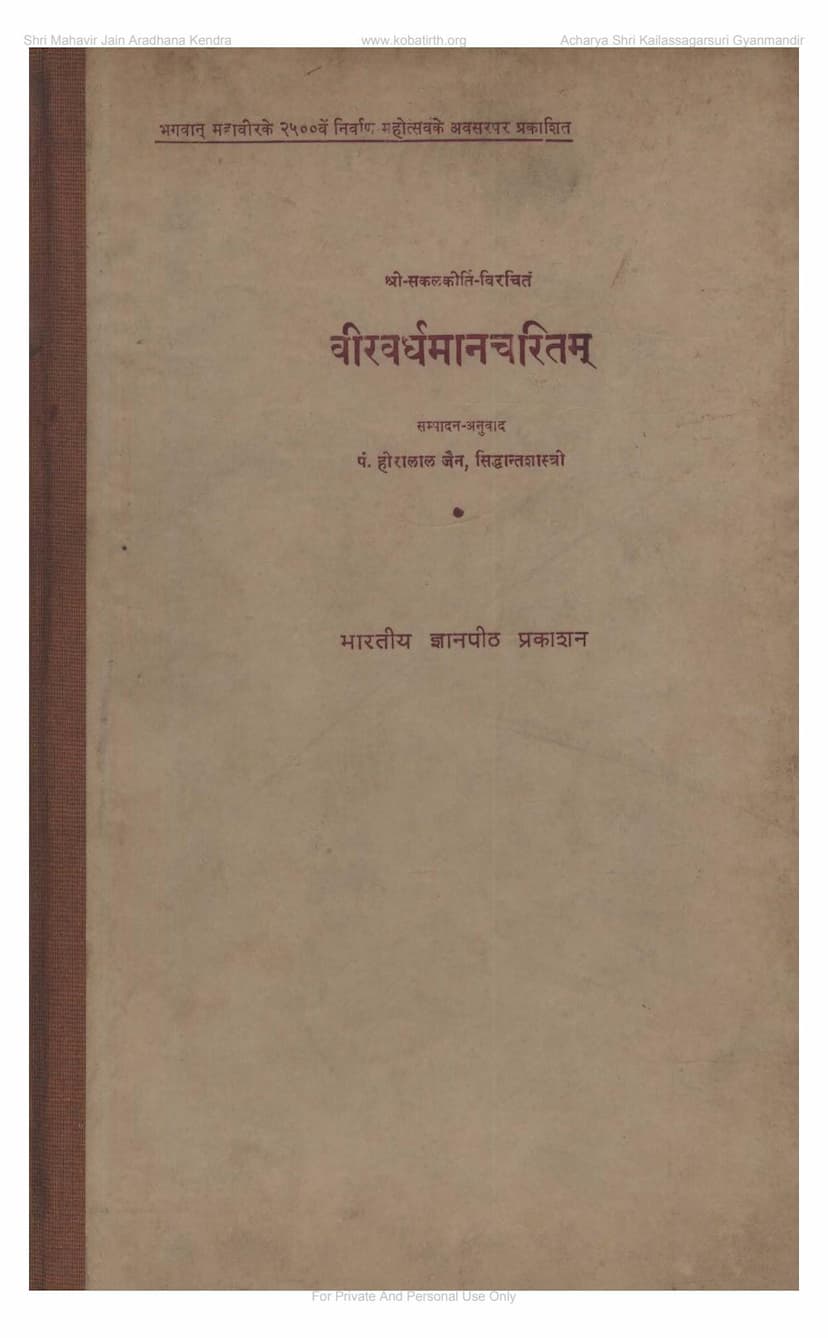Vir Vardhaman Charitam
Added to library: September 2, 2025

Summary
Here's a comprehensive summary of the Jain text "Vir Vardhaman Charitam" by Sakalkirti, as found in the provided pages:
Title: Vir Vardhaman Charitam Author: Sakalkirti Editor/Translator: Pt. Hiralal Jain, Siddhantashastri Publisher: Bharatiya Jnanpith Publication Context: Released on the occasion of the 2500th Nirvana Mahotsava of Bhagavan Mahavir.
Overview: The "Vir Vardhaman Charitam" is a Sanskrit work by Acharya Sakalkirti that narrates the life of Bhagavan Mahavir, the 24th Tirthankara of Jainism. This summary is based on the provided introductory and contextual pages, which include the preface, editorial notes, and table of contents, offering insights into the work's content, its author, and its significance within Jain literature.
Author - Sakalkirti: Acharya Sakalkirti was an influential Bhattaraka (a monastic leader) and a prolific writer. The text suggests he lived during the period of the Bhattaraka tradition, which, despite some criticisms from later periods (like Pandit Ashadhar's mention of potential flaws in conduct), played a significant role in the preservation and propagation of Jain literature. Sakalkirti is noted for his wide-ranging scholarship, having authored numerous works across various fields of Jain philosophy and literature, including the four Anuyogas (scriptural classifications). His lifetime is estimated to be from Vira Samvat 1437 to 1499 (approximately 1380 AD to 1442 AD), based on inscriptions and historical records.
Content and Structure: The "Vir Vardhaman Charitam" is a biography of Bhagavan Mahavir, presented in a narrative style. Based on the table of contents provided, the work is structured into nineteen chapters (Adhikaras).
- Focus on Pre-birth Lives: The initial chapters (First six) are dedicated to describing Mahavir's previous lives, a common practice in Jain biographies to highlight the Tirthankara's spiritual journey and the merit accumulated over lifetimes that leads to their exalted status.
- Life of Mahavir: The remaining thirteen chapters detail his life after enlightenment, including his preaching, the establishment of the Samavasarana (a divine assembly), and his interactions with his disciples.
- Key Themes and Teachings: The text appears to cover various aspects of Jain philosophy and practice. It includes descriptions of:
- The concept of Tirthankara-hood and its special significance.
- The importance of "Kalyanaks" (auspicious events in a Tirthankara's life like conception, birth, renunciation, enlightenment, and salvation).
- The philosophical underpinnings of Jainism, including the discussion of tattvas (realities), merits of adherence to the Dharma, the fruit of virtues and vices, the twelve austerities (Tapas), and the twelve reflections (Bhavanas).
- The Tirthankara's role as a spiritual guide and the significance of the Samavasarana, where all beings, including animals, could listen to the divine discourse.
- The importance of Ganadharas (chief disciples) and their role in compiling and disseminating the Tirthankara's teachings. The text mentions the importance of Indrabhuti Gautam and the fact that Mahavir's teachings remained unarticulated for 65 days until Gautam became his disciple.
- Comparison with Other Biographies: The preface notes that Sakalkirti's work, while covering the Tirthankara's pre-birth lives and life events similar to other biographies like Asaga's "Mahavir Charitam" and Jinansen's "Harivamsha Purana," doesn't introduce radically new narratives. However, it does highlight a few unique points found in other texts, such as:
- The mention of a relative named Jaitashatru, whose daughter Yashoda was desired for marriage with Mahavir, a detail noted in the Harivamsha Purana.
- The annual celebration of Deepamala (festival of lamps) in India in commemoration of Mahavir's Nirvana, also mentioned in the Harivamsha Purana, which is otherwise not found in other Charita texts.
- Sanskrit Language and Style: The work is composed in Sanskrit, aiming for clarity and accessibility for modern readers, with an accompanying Hindi translation.
Significance and Publication: The Bharatiya Jnanpith, established in 1944, is dedicated to the research, critical editing, and publication of Jain literature in various ancient languages. The "Vir Vardhaman Charitam" is published as part of the Jnanapitha Murtidevi Jain Granthamala, specifically as Sanskrit Grantha No. 45. Its publication on the occasion of the 2500th Nirvana Mahotsava of Bhagavan Mahavir underscores its importance in commemorating the spiritual legacy of the Tirthankara.
Editorial Work: The critical editing and translation were meticulously handled by Pandit Hiralal Jain, a renowned Siddhantashastri. He relied on manuscripts from the A. Pannalal Digambar Jain Saraswati Bhavan, Beawar, and utilized an old Hindi translation of Sakalkirti's work for cross-referencing and textual correction.
Key Jain Concepts Discussed in the Preface/Editorial: The preface and editorial sections touch upon several important Jain concepts:
- Historicality of Mahavir: The text acknowledges Mahavir's historical presence, mentioning his reference in Buddhist Tripitakas as 'Niganth Nataputta'.
- Co-temporality with Buddha: The preface refers to Hermann Jacobi's assertion that Nataputta was a contemporary of Buddha.
- Reincarnation and Karma: The emphasis on Mahavir's previous lives highlights the Jain concepts of reincarnation and the influence of past actions (karma) on present lives.
- Tirthankara Path: The text explains that the highest spiritual attainment in Jainism is Tirthankar-hood, which involves achieving liberation while simultaneously establishing the Dharma Tirth (the four-fold Jain community).
- Samavasarana: The divine assembly where Mahavir delivered his sermons is mentioned, emphasizing its inclusivity and the presence of all types of beings.
- Role of Brahmins in Knowledge Dissemination: The preface acknowledges the significant contribution of the Brahmin community to the spread of knowledge and science in India, noting that many of Mahavir's Ganadharas were Brahmins who embraced Jainism.
In essence, "Vir Vardhaman Charitam" by Sakalkirti, as presented through these pages, is a vital Sanskrit biography of Bhagavan Mahavir, valued for its narrative of his life, previous births, and the spiritual teachings central to Jainism, meticulously brought to light by the Bharatiya Jnanpith.